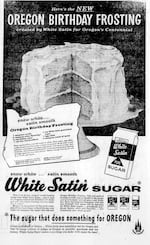OPB’s “Superabundant” explores the stories behind the foods of the Pacific Northwest with videos, articles and this weekly newsletter. To keep you sated between episodes, we’ve brought on food writer Heather Arndt Anderson, a Portland-based culinary historian and ecologist, to highlight different aspects of the region’s food ecosystem. This week she wishes Oregon a happy birthday by looking at the state’s centennial celebration.
Click here to subscribe. For past issues, go here.

opb / OPB
Valentine’s Day is upon us, and while Oregon is home to legions of outstanding chocolatiers, here at Superabundant we’re more focused on cake. Yes, Feb. 14 is also Oregon’s birthday, and while we couldn’t quite fit 164 candles on top, we do have the recipe for the birthday cake that was served at the centennial celebration in 1959. Now that was a birthday cake. How many servings did that colossal cake yield? Read on to find out.
Small Bites: Dry farming in a wet state, giving spuds a month of love and new ways to keep your beef local
Freshly picked morsels from the Pacific Northwest food universe:
In a changing climate, dry farming could be the future of Oregon agriculture.
Even in a state known for its long rainy season, droughty summer weather can impact what we can grow and when. As OPB’s Elizabeth Castillo reports, that’s why farmers and plant science researchers are hard at work exploring crops suitable for dry farming, a technique for growing food without irrigation. Oregon State University’s Dry Farming Collaborative seeks to lead the way in both identifying productive Mediterranean varieties that can be grown without irrigation and uncovering new applications for the dry farming.
February is Potato Lover’s Month.
Last week we celebrated National Tater Tot Day with a story on the history of Oregon’s prodigal spud, but if you’re looking for other Oregon-centric potato dishes, then look no further than the jojo. Jojos aren’t just any other potato wedge, explained Matthew Korfhage in a 2017 story for Willamette Week; they’re specifically breaded and pressure-fried (aka broasted) and, according to lore, may have been invented here in the Northwest by a Vancouver, Washington, Flavor-Crisp brand pressure-fryer salesman. Beloved Portland chicken and jojo haunt Reel M’Inn purportedly still uses an old Flavor-Crisp. Both make very strong cases for the potato’s proposed designation as Oregon’s official state vegetable, as reported by OPB’s Kristian Foden-Vencil.
Where’s the beef (from)?
All this fried potato news makes us crave a juicy burger. Eating locally is easy with vegetables like the tater tot, but do you really know where your meat comes from? OPB’s Kristian Foden-Vencil reported recently that it’s not as straightforward as choosing your favorite ranch or grass-fed burger. Once cattle enter a U.S. Department of Agriculture-inspected abattoir, they’re sorted with animals from who knows where. This happens again at each step, from packing to shipping to the meat counter; the price goes up at every part of the process, but more importantly, it can mean that the meat’s precise source isn’t so easy to pinpoint. Want to be sure you’re buying local? Skip the middle steps and stock your freezer with state-inspected meat bought directly from the ranchers, like the Regenified-certified Carman Ranch, whose meat is processed by state-inspected butcher Valley Meat Service in Wallowa.

Photocomposite of newspaper clippings from the Oregonian and others around Oregon's centennial celebration in 1959.
Various / OPB
Happy birthday, Beaver State
Some of you may be out having a romantic dinner on Valentine’s Day, but never forget that Feb. 14 is also Oregon’s birthday. While there isn’t any single signature dish to represent the state (alas, no Oregon analog to the Maryland crab cake, despite Dungeness crab being far superior to their blue cousins), Oregon does have ingredients that it does better than others.
It begs the question, though: What does Oregon really taste like? Does it taste like the Pacific Ocean — the salt, seaweed and the merroir of oysters, whose flavor depends entirely on where they live?
Does it taste like Douglas fir trees? Like beer? Like pickled beaver tails?
When it was time for Oregon to be feted 64 years ago, these were not the burning questions being pondered. In fact, even Oregon’s birthday cake seems to have been an afterthought.
Oregon throws the party of the century
In 1959, to celebrate the state’s 100th birthday, Portland hosted the Oregon Centennial Exposition and International Trade Fair. Though Oregon officially became a state in the winter, party planners sensibly opted to hold the three-month bash in the summer — and it was quite the event.
Held at what is today the site of the Oregon Expo Center in Portland’s Kenton neighborhood, the official centennial birthday party was a very big deal. The expo site, dubbed “Frontier of the Future,” was 65 acres. It was no 1905 Lewis and Clark Expo (sited on 400 acres of Guild’s Lake, that was the West Coast’s first world’s fair and saw 1,588,000 paying attendees), but it would do, and all in all the Centennial Expo saw nearly the same number of visitors as the Lewis and Clark Expo had.
Harry Belafonte, Lawrence Welk and Roy Rogers played the event. Besides being festooned in the predictable evergreen trees, covered wagons and full-size replica of a generic Wild West town dubbed “Frontier Village,” the exhibition featured a Japanese tea house, a display from the Atomic Energy Commission to promote the benefits of nuclear power and a pool for synchronized swimming performances by the International Water Follies. A 31-foot-tall statue of Paul Bunyan was dedicated to the event — it still stands at N. Interstate and Denver (the statue is now listed on the National Register of Historic Places).
The Oregon Centennial cake received a fair amount of local press, mostly because it was a sensational 5-ton behemoth in the shape of Mount Hood, festooned with candy-covered wagons and tiny candy trees, designed to feed 40,000 people. The mastermind behind the cake was Mardi Jacob, a local cat fancier and dress designer who seemed to be involved any time a mammoth cake was needed. A frosting recipe was developed specifically for the centennial by White Satin Sugar (made from local sugar beets), and was printed in The Oregonian as part of the company’s promotion:

An ad for White Satin Sugar that ran in the Oregonian in 1959.
Unknown
The cake was cut by Assistant Secretary of State Francis Wilcox with help from Mardi Jacob, who wore a fabulous chiffon frock of her own making. But despite all of this attention to throwing the biggest bash the state had ever seen, no one bothered to report on how the birthday cake tasted.
Fortunately, at least one Oregon woman had the presence of mind to clip the cake recipe that appeared in her local newspaper in 1959 (and which was later included in her family’s online cookbook); the humble applesauce-raisin cake recipe is the same as the “Oregon Centennial Cake by Mrs. Nathan Lemert from Lane County” that appears in Fabula’s Famous Recipes by Oregon’s Finest Cooks!, published in 1964 by the Oregon Farm Bureau Women (now called OFB Women’s Advisory Council). Look for the recipe at the end of this newsletter.

This nutty applesauce spice cake was served at Oregon's centennial celebration in 1959.
Heather Arndt Anderson / OPB
Recipe: Oregon Centennial Birthday Cake
Applesauce, walnuts and raisins are all well and good, but if we’d been on the party-planning committee, we might’ve suggested a luscious pear cake topped with hazelnut frangipane. Those are Oregon’s official state fruit and nut, respectively. Or maybe we’d have gone with a berry-forward semifreddo, or a creamy sour cherry clafoutis. At any rate, this is the cake that was said to have been served at Oregon’s 100th birthday party. We’ve made a few alterations to yield a cake with balanced flavor and a more tender crumb. (With all due respect to Eleanor Lemert, this cake needs eggs and no one wants to melt shortening into hot applesauce anymore.) While we’re at it, cream cheese is a more suitable frosting for this cake than the cloying marshmallow fluff suggested by White Satin Sugar in 1959. Makes 1 two-layer cake.
Ingredients:
Oregon Birthday Cake
½ cup neutral oil (like canola or vegetable)
2 large eggs
2 cups unsweetened applesauce
½ cup milk
1 tsp vanilla
2 tsp baking soda
1 ½ cup sugar
3 cups all-purpose flour
1 tsp cinnamon
¼ tsp ground cloves
½ tsp nutmeg
½ tsp fine sea salt
1 cup raisins
1 cup chopped walnuts
Cream Cheese Frosting
1 8-oz brick cream cheese, at room temperature
½ cup (1 stick) unsalted butter, at room temperature
2 cups confectioner’s (powdered) sugar
1 tbsp whole milk
1 tsp vanilla extract
Instructions:
- Preheat your oven to 350°. Grease two round 9″ cake pans and line the bottoms with a circle of parchment paper. Set the cake pans on a rimmed baking sheet.
- In a large mixing bowl, combine the oil, eggs, applesauce, milk and vanilla.
- Whisk together the remaining ingredients except the raisins and walnuts, then add the flour mixture to the applesauce mixture. Stir until thoroughly combined, then fold in the raisins and walnuts.
- Divide the batter evenly among the prepared cake pans and bake for 30-40 minutes or until a toothpick inserted in the middle comes out clean. Turn the baked cakes onto a cooling rack and let them cool completely before you even think about frosting them.
- While the cakes are cooling, prepare the frosting by combining the ingredients with a hand mixer and beating until smooth.
- Place one cake round on a serving plate or cake stand, then spread about ¼” of frosting on top. Center the second cake round on top, then spread the remaining frosting in an even layer on the tops and sides of the cake.
The Superabundant newsletter comes out every Friday. Click here to subscribe.

